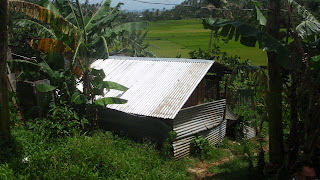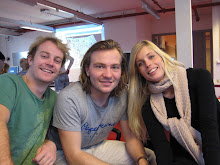After spending five days in Legazpi it was time to move on to Iloilo, but getting there was a different story because we wanted to travel by land to see the countryside. One of our friends, Brother Raoul, a.k.a, Rocky had offered us a ride all the way to Calbayog, so once again we experienced the great generosity and kindness of the people here.
On Saturday morning we drove to Matnog, from were we took a ferry to Allen. Due to an unknown delay our ferry took of one hour later. So once we got off the ferry we were in a hurry to catch the next ferry to Cebu which was leaving at seven o’clock. Unfortunately the roads on Samar island are not as good as in Luzon. There were big holes and it was dark already. We arrived in Calbayog at 19.16 hour. We missed the ferry!
Now we were stuck on Samar till Tuesday. A city where nothing really happens and only a handful hotels are located there.
This gave us the opportunity to evaluate Legaspi and Cavite, and also to update our finance.
Through Brother Rocky we met a woman named Rofel. She took care of us during our stay. She showed us around and told us about her study, and her migration to the States. This is a common think in the Philippines, and actually a big problem. Therefore you have to work for three years in the Philippines before you get your diploma. This is one of the rules that the new President, Gloria Macapagal-Arroyo, proceeded.
Samar island to Iloilo,
Tuesday afternoon we were finally on our way to Cebu. Because there is no direct connection to Iloilo we had to travel over Cebu. This is a twelve hour trip with hundreds of beds on the deck and one Videoke set on board to sing along.
We arrived the next morning in Cebu city. An industrial city that seems to be well developed. After spending half a day there, we took off with the next ferry to Iloilo city. We spend the night on the roof, under the stars. And dolphins swimming next to us.
Iloilo
After 12 hours we finally arrived in Iloilo city. We dropped our bags at the hotel, and went to Jaro, a district off Iloilo witch was most effected during typhoon Frank. We already knew that this was the most vulnerable place of Iloilo city. This is also the place where the most informal settlement are located.We were invited by Ramos into his house.
Meeting with the UAP,
Back in the hotel we by coincidence met an architect who’s office is located in the Hotel. His name is Mel and he is also a member of the UAP, the United Architects of the Philippines.
He invited us that same night to join him for a meeting with the UAP, they attend every month. They gave us a warm welcome, and we were placed at the last table were the big boys are seated. After a dinner and some beers the presentation finally began. First we had to introduce ourselves, which was pretty unexpected especially because we had to talk into a microphone which isn’t very easy to do.Still it was fun to be part of a meeting from the UAP.
The planned presentation was about new materials, like Ecofoam, which is a foam and easy to use and better than other isolating materials, according to the salesman of course. After being criticized by the big boys, the salesman could finally finish his presentation.
Exploration Iloilo city,
The next day we went to see the city planner off Iloilo, which we already met at the meeting the night before. In the office they showed us maps of Iloilo city, which contained the new flood project, the relocation plans of the airport out of the city and the new ring road which will reduce the heavy traffic in the city centre. On the maps you could see resettlement areas as well, this because they are making some roads wider and therefore the houses which are located near the road will be relocated. Also the settlers who lives on the river banks, have to be relocated as well. This because of the danger and new regulations from the government. The plan is that there will be no building structure within twenty meters from the river. This of course for there own safety and environmental concerns.
We met with the president of DENR, Department of Environmental and Natural Resources, Mr. Bing Garnace. They are planting new trees on the riverbanks more upstream. They also intend to process this into the city, once the squatters are gone. This for holding the soil and to prevent future mudslides.
After these three day’s of exploration in Iloilo, we came to the conclusion that Iloilo is actually well developed and is not heaving severe problems after the flooding. They managed to build the destructed homes back in one month time, because the structure itself was still standing and the removal of informal settlements was already in progress, with or without the flood due to typhoon Frank.
The political situation in Iloilo is more the problem these days. Corruption is a major problem as well. In fact The Philippines is the third most corrupted country in the world.
After DENR we went to the NDCP-DND, The National Defense College of the Philippines-Department of National Defense, and talked to Eligio R. Calaor. He send us to Ir. Jose Papa from the ICDCC, Iloilo city- Crisis and Disaster management Centre. Papa was told us more about the government and the corruption. We requested for some maps and plans of Iloilo city which he could not provide us, but Mr. Rony Haresco Firmenza from ICUPAO, Iloilo City Urban Poor Affairs Office, should. He showed us the design of the relocation settlement in the Jaro district.













 At six ‘o clock in the morning Neneng and Sharon from the PRRM picked us up to start our tour around the area of Cavite. Sharon is actually an English marine biologist who now lives in The Philippines. First they took us to a reforestation project. Here they plant new Mangrove plants to stimulate the fish productivity and also to get the Mangrove back again. This is in itself a natural boundary in case of i.e. typhoons and floods. They plant the Mangrove and learn the local community there how to take care of them. They also introduced us to the chief of the community who was really kind and pleased to meet us. After that we drove to a landfill the PRRM and other NGO’s and organizations are demonstrating against. It causes in many ways big problems as landslides and pollution, effecting the natural environment. It’s also against the governments own policy because they made the area too large and too close to a river, which will directly infect the water system of the downstream situated village. Next we visited two women who strive to eat and culture more organic local vegetables. They want to set up a program to learn people how to do this, so they can practice this at home in their own backyard. After this we went back to Manila and they arranged for our bus trip the next day to Naga, near Legaspi. We could spend the night in the dormitory at the PRRM building, and we had a lovely evening with them on the roof terrace.
At six ‘o clock in the morning Neneng and Sharon from the PRRM picked us up to start our tour around the area of Cavite. Sharon is actually an English marine biologist who now lives in The Philippines. First they took us to a reforestation project. Here they plant new Mangrove plants to stimulate the fish productivity and also to get the Mangrove back again. This is in itself a natural boundary in case of i.e. typhoons and floods. They plant the Mangrove and learn the local community there how to take care of them. They also introduced us to the chief of the community who was really kind and pleased to meet us. After that we drove to a landfill the PRRM and other NGO’s and organizations are demonstrating against. It causes in many ways big problems as landslides and pollution, effecting the natural environment. It’s also against the governments own policy because they made the area too large and too close to a river, which will directly infect the water system of the downstream situated village. Next we visited two women who strive to eat and culture more organic local vegetables. They want to set up a program to learn people how to do this, so they can practice this at home in their own backyard. After this we went back to Manila and they arranged for our bus trip the next day to Naga, near Legaspi. We could spend the night in the dormitory at the PRRM building, and we had a lovely evening with them on the roof terrace.






